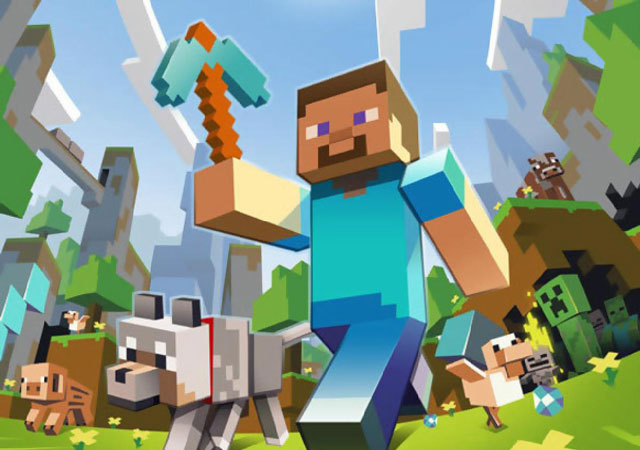
Microsoft is adding a new marketplace — and a brand new currency — within the videogame Minecraft, opening up the opportunity for businesses to sell their original content and creations to tens of millions of the game’s players for the first time.
Set to go live in the spring, nine businesses will be selling feature packs within Minecraft — such as new storylines, in-game activities or landscapes to explore — with prices ranging between about US$1 and $10/creation. Other companies can apply to be allowed into the marketplace over subsequent months. Users wishing to purchase content will need to buy a form of new currency — Minecraft Coins.
“For the first time, we are going to enable creators to come in and put content into our store alongside the same content that Minecraft makes,” said John Thornton, the game’s executive producer at Microsoft. “The real impetus is to let creators connect to players and help them make a living on top of Minecraft.”
A store within the game does already exist but is limited to only items created by the Minecraft development team. The change to allow third-party developers to sell their wares within the same ecosystem opens up an entirely new business model for independent creatives.
“For us, the big step forward is having a stable platform from which we can build a solid business,” said James Delaney, MD of third-party Minecraft developer BlockWorks, which is one of the first companies to be allowed to sell on the store. “We know the community over there is huge and they’re pretty desperate for this kind of content.”
“Huge” is a relative description, but in terms of an addressable market, it’s pretty apt for Minecraft. The game, originally released in 2011 after two years of experimental versions, was acquired by Microsoft via its $2,5bn purchase of software company Mojang in 2014. It has grown to sell over 121m copies worldwide, and has 55m unique monthly players, according to figures provided by Microsoft.
The Minecraft Marketplace will not be available on all platforms — a notable exclusion being Microsoft’s own Xbox and Sony’s PlayStation games consoles — but will be available on Windows, iOS and Android, as well as the Apple TV, the Oculus Rift and Samsung Gear VR virtual reality platforms, and even Amazon’s Kindle Fire.
Developers are free to set prices for their creations. “We don’t have a strong price cap,” said Thornton. “If we have content that shows up that everybody agrees is of significant value that a consumer might want to pay more than that, we’ll have that conversation. Ultimately it’s up to the creator to decide.”
New currency
The new coins can be bought via any supported device that features an app store, such as iOS, Android or Windows. These coins will live in a user’s Microsoft Xbox Live virtual wallet and be accessible for marketplace purchases on any platform. Microsoft would not confirm the exact figure developers would receive from the revenue share after it and app stores took their cut, but Thornton said it would be over half.
“We have a model that allows us to give more than 50% of revenue to the creators,” he said. “They’re all happy with that revenue split and we’re happy with that as well.”
There are restrictions, however, to protect Minecraft’s large numbers of young players. “Every piece of content in the store is reviewed by Minecraft,” said Thornton, so much like Apple’s app store, nothing is likely to hit virtual store shelves without it being vetted first.
By adopting an in-app payment model, Microsoft is moving into a territory well-trodden by so-called freemium mobile apps. Pokemon Go, which is free to download, generated almost $1bn of revenue in 2016 through in-app payments, according to data compiled by research group App Annie.
“With Minecraft Coins, Microsoft is following both Amazon and Facebook into having its own virtual currency for in-app and content purchasing,” said Martin Garner, an analyst at CCS Insight. “This could be very relevant for Minecraft’s substantial base of younger users, who are unable to attach a credit card to their account. But, by using the Minecraft brand for the currency, Microsoft appears to see this as a self-contained move, rather than the start of something larger.”
Future businesses
Another notable restriction is that the store is not a free-for-all. At launch, nine businesses will be selling their goods to players. This includes BlockWorks, which had previously worked on commercial Minecraft commissions from Disney, and Blockception, which once created an in-game replica of the International Space Station on commission from the UK Space Agency.
“We’ve been working with these creators for several months to basically come up with the right content and the right system for them to sell stuff,” said Thornton. “We will be expanding the store and we’ll be looking for creators that are doing this as a professional business. We’re going to review the applications and bring on new creators over the coming months.”
For businesses and creators like BlockWorks’ Delaney, the move allows his company to move in a whole new direction after the game’s developer Mojang enforced a change in commercial guidelines to prevent Minecraft from being used as an open marketing platform to sell products.
“We previously did a bit of Minecraft to promote films and we did some stuff for Disney’s Tomorrowland,” Delaney said. “But the commercial guidelines that came a year and a bit ago sort of disabled us from doing that. The great thing about the marketplace is the return to the commercial opportunity that Minecraft represents for us.” — (c) 2017 Bloomberg LP




